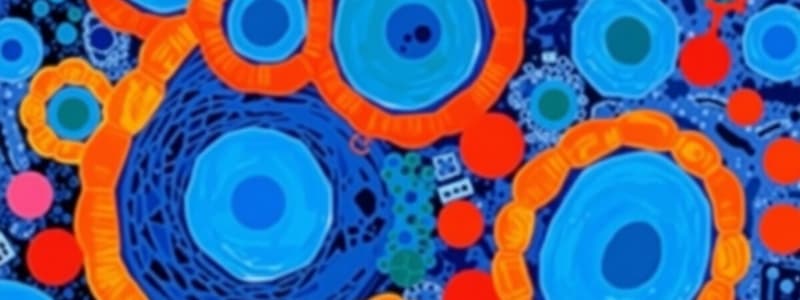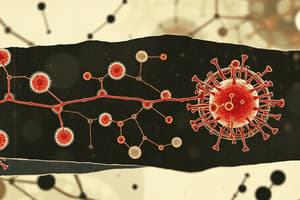Podcast
Questions and Answers
What is the approximate size range of exosomes?
What is the approximate size range of exosomes?
- 1-10 nanometers
- 40-100 nanometers (correct)
- 100-500 nanometers
- 20-50 nanometers
Which of the following is a general characteristic of exosomes?
Which of the following is a general characteristic of exosomes?
- Inability to carry proteins
- Inclusion of a nucleus
- Ability to replicate independently
- Presence of a phospholipid bilayer (correct)
What distinguishes exosomes from other extracellular vesicles, besides general size and shape?
What distinguishes exosomes from other extracellular vesicles, besides general size and shape?
- Presence of ribosomes
- Specific DNA sequences
- Unique protein and lipid composition (correct)
- Lack of a membrane
During exosome biogenesis, how are exosomes initially formed?
During exosome biogenesis, how are exosomes initially formed?
What is the role of ESCRT machinery in exosome biogenesis?
What is the role of ESCRT machinery in exosome biogenesis?
What are the possible fates of MVBs during exosome biogenesis?
What are the possible fates of MVBs during exosome biogenesis?
What role do RAB proteins play in exosome secretion?
What role do RAB proteins play in exosome secretion?
What is the likely function of SNAREs in exosome biogenesis?
What is the likely function of SNAREs in exosome biogenesis?
Besides ESCRT machinery, what other components are involved in the biogenesis of ILVs?
Besides ESCRT machinery, what other components are involved in the biogenesis of ILVs?
What is a key characteristic of exosomal cargo that makes them useful for research?
What is a key characteristic of exosomal cargo that makes them useful for research?
Which molecular components are commonly found in exosomes, regardless of the cell type from which they originate?
Which molecular components are commonly found in exosomes, regardless of the cell type from which they originate?
What distinguishes secreted miRNAs from passively leaked miRNAs?
What distinguishes secreted miRNAs from passively leaked miRNAs?
What are the main pathways for circulating miRNAs to enter the circulation?
What are the main pathways for circulating miRNAs to enter the circulation?
How might disrupting the function of the retromer complex affect Wnt signaling mediated by exosomes?
How might disrupting the function of the retromer complex affect Wnt signaling mediated by exosomes?
Which of the following best describes the role of Evi in exosome-mediated Wnt signaling?
Which of the following best describes the role of Evi in exosome-mediated Wnt signaling?
How does the use of differential ultracentrifugation impact the study of Wnt signaling via exosomes?
How does the use of differential ultracentrifugation impact the study of Wnt signaling via exosomes?
How does blocking MVB formation with Bafilomycin A1 affect Wnt signaling?
How does blocking MVB formation with Bafilomycin A1 affect Wnt signaling?
Based on Western blot analysis, what proportion of Wnt3A is estimated to be secreted via exosomes in L cells?
Based on Western blot analysis, what proportion of Wnt3A is estimated to be secreted via exosomes in L cells?
Flashcards
Exosomes
Exosomes
Extracellular vesicles (EVs) that are not cells, containing cellular material encased in a phospholipid bilayer.
Exosome formation
Exosome formation
Formed as intraluminal vesicles (ILVs) by budding into early endosomes and multivesicular bodies (MVBs).
Exosomal marker proteins
Exosomal marker proteins
Proteins such as Alix, flotillin, TSG101, and CD63 that are enriched in exosomes.
ESCRT Machinery
ESCRT Machinery
Signup and view all the flashcards
MVB Biogenesis
MVB Biogenesis
Signup and view all the flashcards
RAB GTPases Role
RAB GTPases Role
Signup and view all the flashcards
Tetraspanins Function
Tetraspanins Function
Signup and view all the flashcards
SNARE Complexes
SNARE Complexes
Signup and view all the flashcards
Exosome Interactions
Exosome Interactions
Signup and view all the flashcards
Wnt Proteins
Wnt Proteins
Signup and view all the flashcards
Wnts and Exosomes
Wnts and Exosomes
Signup and view all the flashcards
SNARE complexes
SNARE complexes
Signup and view all the flashcards
Wnt Packaging Modes
Wnt Packaging Modes
Signup and view all the flashcards
Exosome purification
Exosome purification
Signup and view all the flashcards
Shh Signaling
Shh Signaling
Signup and view all the flashcards
Evi Role
Evi Role
Signup and view all the flashcards
Retromer complex
Retromer complex
Signup and view all the flashcards
Exosomes
Exosomes
Signup and view all the flashcards
Study Notes
Exosomes
- Extracellular vesicles (EVs) are not cells, but contain cellular materials within a phospholipid bilayer
- Exosomes form a specific class of EVs
- Exosomes range in size from ~40-100 nm
- Unique protein and lipid composition defines exosomes
Exosome Biogenesis
- Exosomes originate as intraluminal vesicles (ILVs) of endosomal multi-vesicular bodies (MVBs)
- These MVBs fuse with the cell surface through an exocytic process
- Exosomes get released with the exocytic fusion of MVBs and the plasma membrane
Exosomal Markers
- Exosomes transport cell-specific and cell-independent biomarkers, depending on origin cell
- Exosomes contain proteins involved in membrane transport, fusion, and MVB biogenesis
- Proteins found in exosomes include:
- Rab GTPases
- Annexins
- Flotillin
- Alix
- TSG101
- Exosomses are involved in heat shock protein processes
- Contain intergrins and tetraspanins
- CD63
- CD9
- CD81
- CD82
- Exosomal marker proteins include Alix, flotillin, TSG101, and CD63
- Enrichment in cholesterol, sphingolipids, ceramide, and glycerophospholipids with long and saturated fatty-acyl chains is another exosome feature, uniquely defining their lipid bilayer
Vesicle transport - Nobel Prize
- The 2013 Nobel Prize in Physiology or Medicine was awarded for discoveries of machinery regulating vesicle trafficking.
- James E. Rothman, Randy W. Schekman and Thomas C. Südhof were the recipients
Endosomal Sorting Complexes (ESCRT)
- The ESCRT machinery is a set of cytosolic protein complexes (ESCRT-0, ESCRT-I, ESCRT-II, ESCRT-III)
- ESCRT complexes facilitate membrane remodeling, leading to MVB formation and budding
- ESCRT components have been studied in organisms like yeast and humans
- The ESCRT machinery is involved in MVB biogenesis, cellular abscission, and viral budding
- MVB biogenesis sees ubiquitin-tagged proteins enter endosomes via vesicle formation
- Viral budding often requires ESCRT machinery, as is the case with HIV
More on Exosome Biogenesis
- MVBs appear along the endocytic pathway
- They are characterized by the presence of vesicles (ILVs) in their lumen, formed by inward budding from the limiting Membrane
- The RAB family of small GTPase proteins regulates intracellular vesicular trafficking
- These steps include:
- Vesicle budding
- Vesicle and organelle mobility via cytoskeleton interaction
- Vesicle docking to target, membrane fusion
SNAREs
- Soluble NSF-attachment protein receptor (SNARE) complexes facilitates lipid bilayer fusion between the compart- ments
- VAMP7 is essential for the release of acetylcholinesterase-containing exosomes
- R-SNARE protein YKT6 is needed for the secretion of WNT3A containing exosomes
Exosome Binding and Uptake
- Topology of exosomes is similar to cells, with external receptors/ligands and internal cytoplasmic proteins/RNAs
- Exosomes interact with cells through EV release, surface binding, membrane fusion, and endocytosis
Wnt Signaling
- Wnt proteins regulate interactions during embryogenesis
- Aberrant Wnt signaling is associated with cancers
- Wnt proteins bind Frizzled family receptors (GPCRs)
- This includes GSK3β differential phosphorylation and destruction complex-mediated control of beta-catenin localization
- Release of beta-catenin from a destruction complex, followed by entry into the nucleus and transcription activation, forms a complex with TCF to activate transcription of Wnt target genes
Exosomes and Wnt Interactions
- Differential regulation controls Wnt molecules and affects morphogen spreading and signaling
- Different forms of Wnts might appear to be not be mutually exclusive
- Vesicle-bound Wnt removal only lowers Wnt activity, so other secretion routes exist, maybe through direct plasma membrane release, and that has different extracellular trafficking properties
Wnt Secretion
- Exosome-dependent Wnt secretion uses exosome sorting machinery
Exosomes and Wnt Activity Assays
- Adding Wnt3A-conditioned medium induces TCF/Wnt reporter activity in HEK293 cells
- Compared to Wnt, purified exosomes have a significant capability to induce Wnt signalling
- 40% of Wnt3A is secreted on exosomes from L cells
Wnt Cargo Receptor Evi
- Wnt cargo receptor Evi is needed to secrete both forms of Wnts into the supernatant
- Decreasing protein Evi by short hairpin RNA (shRNA)-mediated silencing decreases Wnt released
- Evi is required for Wnt protein release on exosomes
Other Regulators
- Under normal conditions, Wnt3A localizes in puncta inside enlarged endosomes, similar to its MVB colocalization with CD81 and TSG101
- Dysregulation with bafilomycin causes disassembly of endosomes, Bafilomycin A1 prevents separation of Evi Wnt complexes
- Bafilomycin A1 leads to mixed secretory lysosomal organelles, and inhibits acidification blocking proper sorting into MVBs
- GW4869 is an exosome biogenesis inhibitor, but the Wnt3A-positive puncta stay inside the enlarged endosomes, with the later maturation and trafficking of MVB impairs
- NH4Cl, but not GW4869, inhibits exosomal Wnt secretion implying that the inhibitor affects general membrane segregation at MVBs and may switch the equilibria from exosomal to other form of Wnt secretion
Retromer Complex
- This complex sorts membrane proteins and recycles them trans-Golgi from endosomes
- SNX3 sorting route may determine if unloaded Evi cycles to the Golgi or the Evi-Wnt complexes are packaged on exosomes, since depletion of retromer leads to lysosomal sorting
- Retromer works upstream of MVB sorting of Evi-Wnt complexes, evident through the effect of ESCRT and Ykt6 RNAi on Wnt/Evi and the exosomal marker CD81
Shh morphogen
- The paper’s findings support Shh morphogen transport using vesicle transport, secretion along cytonemes/filopodia leading to spatial restricted signaling
Studying That Suits You
Use AI to generate personalized quizzes and flashcards to suit your learning preferences.




